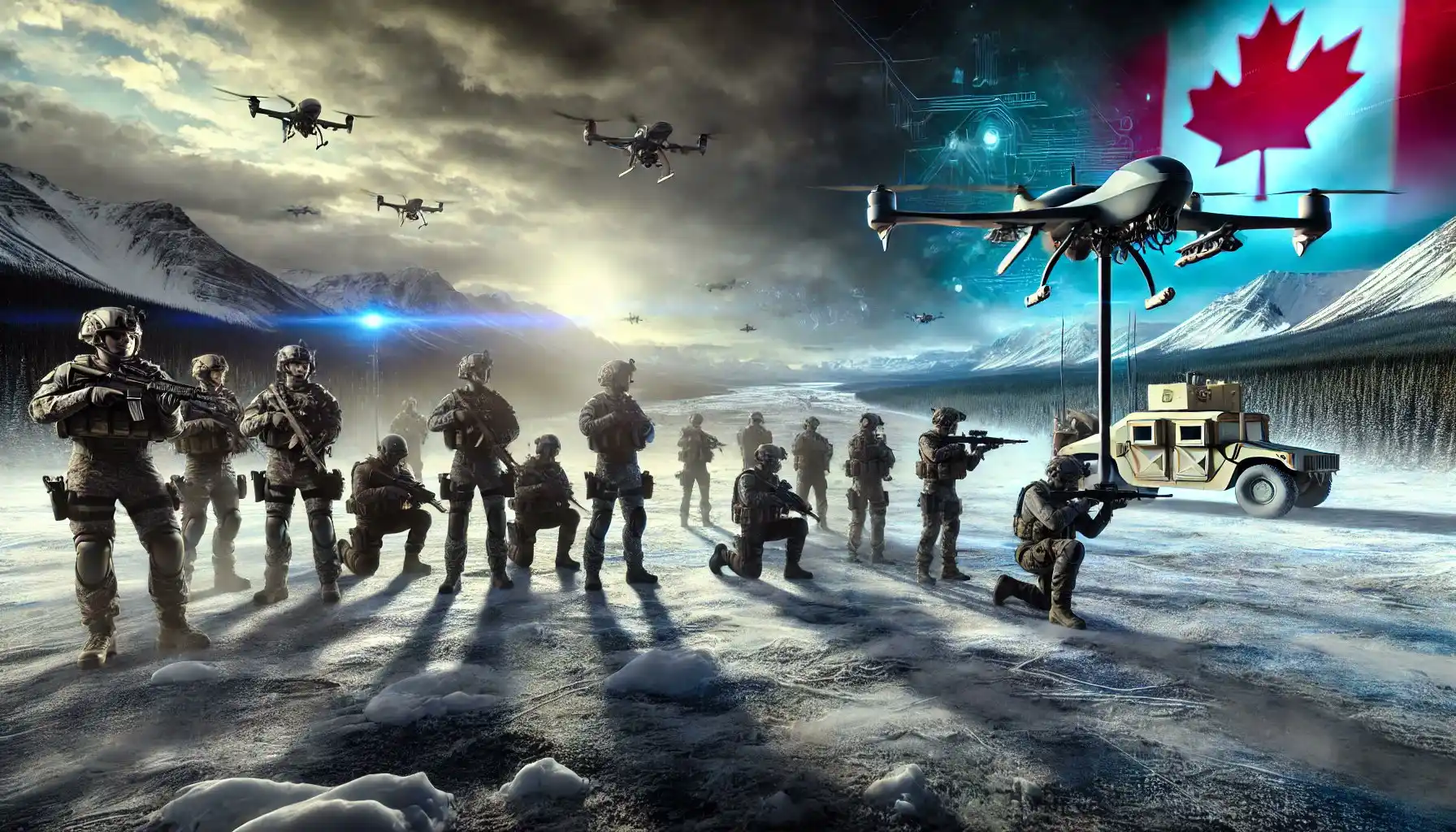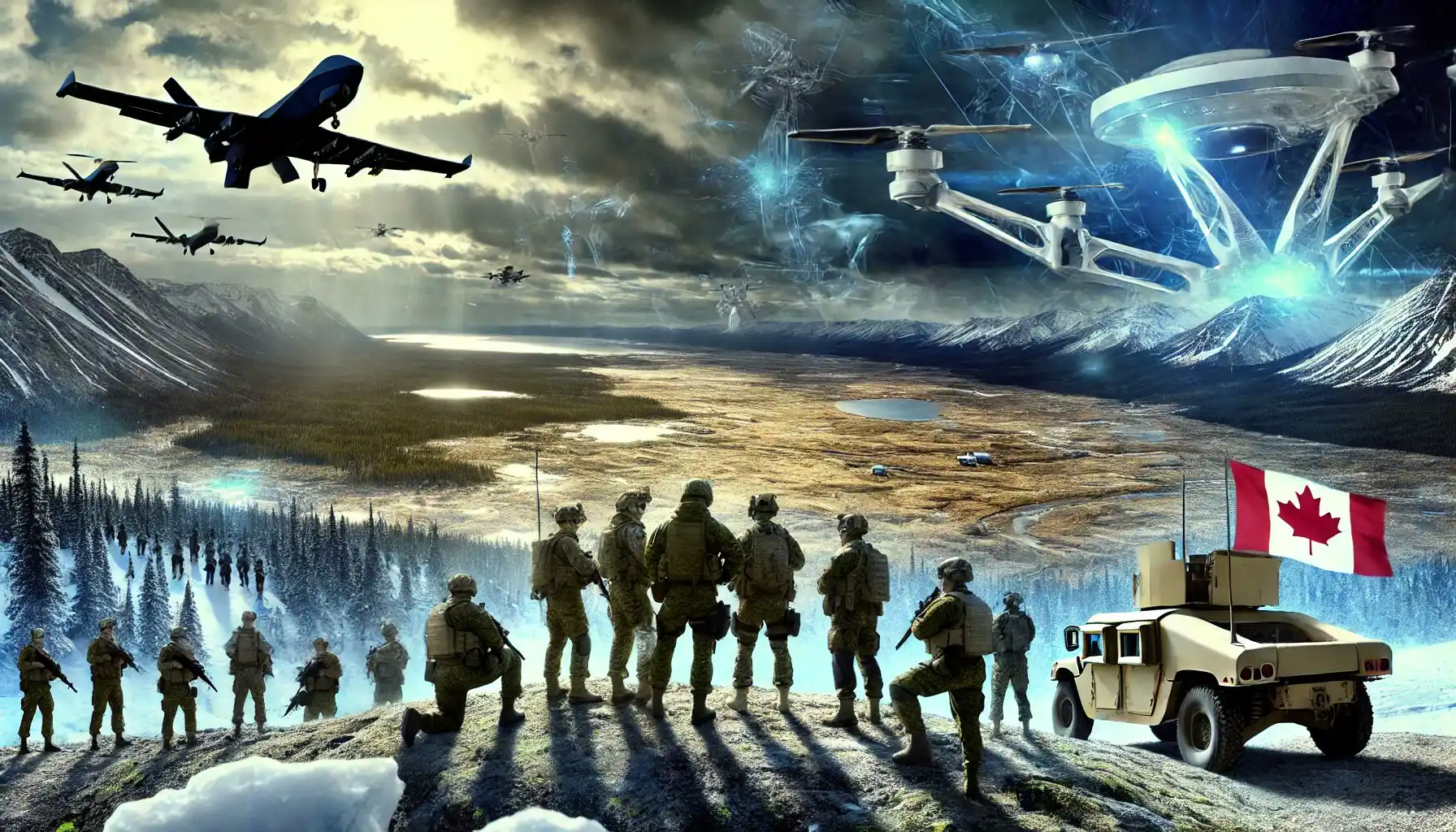1. Strategic Balance Between Human and Autonomous Forces
1.1. Current Limitations:
1.2. Case Study: China’s Integration Strategy
1.3. Recommendations for Canada:
2. Amplifying Force Through Scale and Industrial Base
2.1. China and Russia’s Manufacturing Edge:
2.2. Impact on Canada:
2.3. Strategic Recommendations:
3. Operational Risks of Purely Autonomous Systems
3.1. Lack of Flexibility in Complex Environments:
3.2. Ethical and Strategic Oversight:
3.3. Recommendations for Operational Flexibility:
4. Dependence on Foreign Manufacturing and Technology
4.1. Shipbuilding and Aerospace Constraints:
4.2. Comparative Analysis with China’s Industrial Ecosystem:
4.3. Recommendations for Enhanced Industrial Self-Sufficiency:
5. Economic and Infrastructure Stagnation
5.1. Electrification and Manufacturing Shortfall:
5.2. Recommendations for Infrastructure Growth:
6. Human Capital and STEM Workforce: The Foundation of National Security
6.1. Critical Skills Gap:
6.2. Need for STEM-Driven Policies:
6.3. Recommendations for Workforce Development:
6.4. Strategic Recommendation: Force Multiplication through Autonomous Multi-Domain Swarming and Human-Autonomy Synergy
-
Autonomous Swarming Across Domains: A multidimensional swarm composed of autonomous units in each domain creates a unique layer of operational flexibility. This strategic layering allows Canada to engage in simultaneous attacks and defensive maneuvers, stretching adversary resources thin and enabling Canada’s forces to exploit gaps in enemy defenses effectively. Autonomous units can coordinate in real-time, forming a complex, self-organizing network that operates as a powerful force multiplier.
-
Enhanced Effectiveness through Human-Autonomy Synergy: While autonomous systems are highly effective for repetitive, scalable tasks, human operators remain essential to provide context-sensitive, ethical decision-making, particularly in complex, culturally nuanced, or unpredictable environments. This human-autonomy integration allows Canada to maintain its reputation for responsible and adaptable warfare, ensuring autonomous systems are used to their full potential without sacrificing ethical standards.
-
Adaptability and Advanced AI Capabilities: Continued investment in AI and machine learning will further enhance the effectiveness of autonomous swarms, allowing them to adapt mid-operation based on real-time data. This adaptability is particularly advantageous in diverse terrains, such as the Arctic, where situational challenges are constantly evolving. Paired with human oversight, this advanced AI capability allows Canada’s forces to react fluidly and strategically, adding another layer to the force multiplication effect.
-
Swarm Tactics as a Force Multiplier: Swarming tactics in each domain — land, sea, air, and space — enable autonomous units to overwhelm adversaries by sheer volume and speed. This approach has proven effective in asymmetrical engagements, allowing smaller forces to disrupt, fragment, and effectively counter larger formations. In this context, Canada’s military presence can mimic the impact of a larger traditional army, compensating for its smaller troop size with superior agility and tactical advantage.
7. Conclusion: A Strategic Path Forward for Canada
-
Expand Domestic Manufacturing: Build a sustainable defense industry to reduce reliance on foreign suppliers, focusing on naval and aerospace capabilities.
-
Strengthen the STEM Workforce: Prioritize STEM education and training aligned with defense needs, creating a technically skilled workforce that strengthens national security.
-
Scale Up Infrastructure Investments: Enhance the power grid, fortify against EMP threats, and invest in digital security for long-term resilience.
-
Enhance Maritime and Arctic Defense: Secure Canada’s strategic interests in the Arctic and Pacific with expanded shipbuilding and naval capabilities.
-
Implement Multi-Domain Autonomous Swarming with Human Oversight: Establish a force-multiplying swarm of autonomous units across land, sea, subsurface, aerospace, and space, amplified through the strategic integration of human oversight. This approach maximizes Canada’s reach and response capacity against larger adversaries while preserving ethical standards and adaptability.


Related Content:
Title:“Safeguarding Canada’s Future: Addressing Economic Stagnation, Defense Vulnerabilities, & National Identity” https://x.com/SkillsGapTrain/status/1853056506750529580
Title: “Cultural Re-Engineering? Investigating the Systematic Reduction of Christian and White Representation in Canada’s Public Institutions & Funded Establishments” https://x.com/SkillsGapTrain/status/1855461471431643439
Title: “The Universal Language of Knowledge: AI, Censorship, & the Future of Technological Progress” https://x.com/SkillsGapTrain/status/1855229889068068912
Title: “The Universal Language of Knowledge: AI, Censorship, & the Future of Technological Progress” https://x.com/SkillsGapTrain/status/1854380531430957229
Title: “Thank you for initiating the crucial dialogue to end the ‘deadly drug experiment’ under David Eby’s leadership.” https://x.com/SkillsGapTrain/status/1825627485809045906
Title: “Breaking the Chains: Unveiling the Barriers to Structured Thinking and Professionalism in Canada’s Economy” https://x.com/SkillsGapTrain/status/1817948868354646356
Title: “The Withheld Honour and Silent Sacrifices: Society’s Failure to Recognize and Reward True Excellence at Olympics” https://x.com/SkillsGapTrain/status/1817892568144715797
Title: “Provincial decriminalization isn’t ambitious enough. We need global decriminalization!”https://x.com/SkillsGapTrain/status/1815455611037118912
Title: “Provincial decriminalization isn’t ambitious enough.” https://x.com/SkillsGapTrain/status/1815459750278017467
Title: “BRICS vs. Soviet Union: How a United Bloc Surpasses the Cold War Superpower” https://x.com/SkillsGapTrain/status/1847423165775171895
Title: “Unmasking Global Titans: How China and Russia’s Industrial Economy Exposes Western GDP Illusions” https://x.com/SkillsGapTrain/status/1848150805079081305
Title: “The Role of Sheriffs and the Disintegration of National Police Functions in Canada” https://x.com/SkillsGapTrain/status/1814632355186790460
Title: “Analysis of Factors Leading to Reduced Family Formation and Decline in Birth Rates in Western Countries” https://x.com/SkillsGapTrain/status/1808664505062470025
Title: “Undermining Bravery, Strength, Valour, and Freedom: The True Cost of the Assault on Combat Sports” https://x.com/SkillsGapTrain/status/1809347762498031762
Title: “Ideological Subversion and the Demoralization of RCMP Officers” https://x.com/SkillsGapTrain/status/1812965996048658902s
Title: “Defenders of Freedom: Canada’s Military, Peacekeeping, & Humanitarian Impact (1900-2024)” https://x.com/SkillsGapTrain/status/1854005141810139557
Title: “RCMP’s relentless pursuit in dismantling one of the largest drug operations in Canadian history serves as a powerful reminder of what defines Canada at its core…” https://x.com/SkillsGapTrain/status/1852096295122669947
Title: “Canada’s Crossroads in 2024: Navigating Canada’s Future Under Near-Absolute Authority” https://x.com/SkillsGapTrain/status/1849932362613666170
Title: “The Strategic Importance of Canada in World War 3” https://x.com/SkillsGapTrain/status/1811674417812111626
Title: “To anyone who has ever interacted with a police officer, met someone aspiring to join the force, been saved by their courageous efforts, or watched a child express dreams of wearing the badge — pause for a moment.” https://x.com/SkillsGapTrain/status/1852415955382481097
Title: “The Dragon’s New Clothes: How the CCP Mirrors Neoliberalism of Liberal Party (2015 to 2024)”https://x.com/SkillsGapTrain/status/1824274616149262565
Title: “An intriguing thought experiment here: Imagine if President Trump actually proceeded with mass deportations of unauthorized immigrants from the U.S., and Mexico decided not to take them back.” https://x.com/SkillsGapTrain/status/1855123274528694696
Title: @PierrePoilievre Dear Pierre Poilievre, Conservative Party and Canadians,..”https://x.com/SkillsGapTrain/status/1844763773262819332
Title: “At the outset of the war in 1939, Canada’s population was around 11 million.” https://x.com/SkillsGapTrain/status/1841318964653408400
Title: @NorthrnPrspectv, we want to expand on a crucial point that we see developing with Bill C63 & Liberal Party & PM Trudeau efforts.https://x.com/SkillsGapTrain/status/1840155004071776513
Title: “Why Canada is the Greatest Nation on the Planet” https://x.com/SkillsGapTrain/status/1854323924731101321
Title: “Defenders of Freedom: Canada’s Military, Peacekeeping, & Humanitarian Impact (1900-2024)” https://x.com/SkillsGapTrain/status/1854005141810139557
Title: “Unleashing Canada’s Potential: Axing the Barriers to Land and Prosperity” https://x.com/SkillsGapTrain/status/1806452246068007323
Title: “Canada’s Hidden Frontier: 99.75%+ Untapped Potential and Unclaimed Wealth”https://x.com/SkillsGapTrain/status/1806429928914825379
Title: “Canada’s Future: Addressing Economic Stagnation, Defense Vulnerabilities, & National Identity” https://x.com/SkillsGapTrain/status/1853056506750529580
Title: “Forging Canada’s Future: A Unified Curriculum of Tradition and Technological Mastery” https://x.com/SkillsGapTrain/status/1850028223909810680
Title:“The Integration of Spirituality and Philosophy into Scientific Frameworks: A Holistic Approach to Advancing Knowledge” https://x.com/SkillsGapTrain/status/1852572974865363079
Title: “Integrating Science, Philosophy, and Spirituality: A Comprehensive Response to Dawkins and Peterson” https://x.com/SkillsGapTrain/status/1851435254298374283
Title: “Designing the Superior Fighting Force for the 21st Century: Integrating Blockchain Technology, Artificial Intelligence, Engineering Innovations, & Modern Military Strategies” https://x.com/SkillsGapTrain/status/1844981829750665720
Title: “Modern Warfare & Canada’s Defence: Proposing a Modernized National Ranger Force Like Lucas Botkin with SIG MCX SPEAR and CADEX in Canada”https://x.com/SkillsGapTrain/status/1855084591255896406
Title: “China’s defense industrial base is operating on a wartime footing, while the U.S. defense industrial base is largely operating on a peacetime footing.” https://x.com/SkillsGapTrain/status/1855867151363567693
Title: “Decoding the Security Enigma: An Analytical Examination of Justin Trudeau’s Governance and Canada’s Vulnerabilities in National Security” https://x.com/SkillsGapTrain/status/1846617485350502431
Title: “What you talking about. We live in Canada. This is European region or Western region of the world. Regions don’t just change.” https://x.com/SkillsGapTrain/status/1843597434863206539
Title: “The Great Schism Revisited: A Path to Spiritual, Philosophical, and Technological Unity, Aiming for Heaven, Not Hell”https://x.com/SkillsGapTrain/status/1834784171291471885
Title: “The Evolution of Thought: From the Birth of Islam to Modern Engineering and Philosophy” https://x.com/SkillsGapTrain/status/1833941005382680676
Title: “The Knowledge Singularity in Modern Engineering: Integrating Spirituality, Philosophy, Ethics & AI for a Positive Tech Vision” https://x.com/SkillsGapTrain/status/1834246753391948096
Title: “Science-Deception: How PM Trudeau Ignores Science and Greta Thunberg Rejects Scientific Study for Activism” https://x.com/SkillsGapTrain/status/1831309288553513314
Title: “Roots of Knowledge: How Religion & Philosophy Shape Moral Foundations in an Era of Ideological Chaos” https://x.com/SkillsGapTrain/status/1831229492544913613
Title: “Guarding the Citizens: The Essential Role of Citizenship Ceremonies in Canadian Identity & Authority” https://x.com/SkillsGapTrain/status/1821618080717382120
Title:“Unmasking the Assault: How Ideological Subversion and a Disregard for Heritage Are Undermining Canada’s Military” https://x.com/SkillsGapTrain/status/1819870765086339413
Title: “Canada’s Future at Risk: The New Global Threats to Our Borders and Security” https://x.com/SkillsGapTrain/status/1824932362905333768
Protecting Professional Integrity: Ensuring Independence and Diversity in Canada’s Professional Societies” https://x.com/SkillsGapTrain/status/1817143821873893803
Title: “The Lost Generations: How Canada’s Immigration Policies & HR Failed Millennials and Gen Z”https://x.com/SkillsGapTrain/status/1812700680345596004
Title: “Battle for Humanity: How Rising Ideological Extremism Could Ignite a Century of Conflict”https://x.com/SkillsGapTrain/status/1830676962895110416
Title: “The Soviet Union vs. Dr. Jordan B. Peterson: How Far the USSR Would Go to Annihilate an Ideological Threat”https://x.com/SkillsGapTrain/status/1847382579386995078
Title: “Guardians of the West: Defending Canada’s True Identity”https://skillsgaptrainer.com/guardians-of-the-west-defending-canadas-true-identity/
Title: “Is Canada Facing a Religious Arson War?” https://skillsgaptrainer.com/is-canada-facing-a-religious-arson-war/
Title: “The Evolution and Philosophy of Technological Progress: Beyond Postmodernism” https://x.com/SkillsGapTrain/status/1851187087611199535
Title: “From Unity to Division: The Erosion of Christian Values and the Rise of Woke Culture” https://skillsgaptrainer.com/the-erosion-of-christian-values-and-the-rise-of-woke-culture/
Title: “The Cultural Clash: Western Europe’s Demographic Shifts and the Risk of Future Conflict” https://skillsgaptrainer.com/the-cultural-clash-western-europe/
Title: “Why a Naval Invasion of BC Is Easier from China than India: A Strategic Breakdown”https://x.com/SkillsGapTrain/status/1846508482700440029
Title: “Critique of the 15-Minute City Model: A Call for Practicality, Sustainability, and Security” https://x.com/SkillsGapTrain/status/1843922512050004143
Title: “The Great Convergence: Resisting the Digital Authoritarianism & Centralized Control of Smart Cities for a Future of Genuine Progress and Freedom”https://x.com/SkillsGapTrain/status/1843323244805538150
Title: “Battle for Humanity: How Rising Ideological Extremism Could Ignite a Century of Conflict” https://x.com/SkillsGapTrain/status/1830676962895110416
Title: “You’re absolutely right — Canada is far from ready, and it’s time we acknowledge the truth about our military capabilities.”https://x.com/SkillsGapTrain/status/1840141909857116275
To see our Donate Page, click https://skillsgaptrainer.com/donate
To see our YouTube Channel, click https://www.youtube.com/@skillsgaptrainer